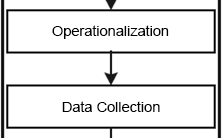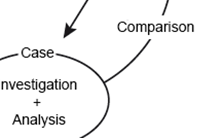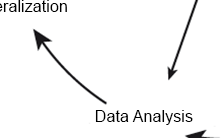The process of academic research
There is a wide range of opinions on how to proceed when doing academic research. At this point, we would like to mention two common models for the research process: the linear and the circular model; both have proven to be useful for Geography students.
The linear model (fig. 1) is used when doing quantitative research since its main purpose is to discover causal relationships or attain numerical representativeness. In doing so, it is important to always collect data in the exact same manner to make sure that results are representative and statistically comparable. The circular model (fig. 2) is particularly used when doing qualitative research since it most notably deals with the reconstruction and comprehension of social processes.
 Fig. 1: Linear model of a research process. Source: Diagram by author based on Aerni et al. (1998) and Flick (1995: 61 und 83).
Fig. 1: Linear model of a research process. Source: Diagram by author based on Aerni et al. (1998) and Flick (1995: 61 und 83).
Quantitative results could be as follows: «62% of the population is content with the government» or «45% of the water runoff as regards the XY river is caused by melting water in summer.»
In contrast to doing quantitative research the general conditions of qualitative research are at first less definite. It is necessary to determine basic data (sampling) step by step (or from case to case) before collecting and analyzing them. Then these data have to be compared in order to provide further contributions to theory (Braun et al. 1987; Speck 1980). Its advantage is the discovery and incorporation of new findings when doing research. Representativeness is not achieved by surveying as many cases as possible but by selecting a wide range of interesting and relevant cases before examining them in more depth.
Results of qualitative research could be as follows: «Farmers fear official paternalism when it comes to new nature conservation projects while the tourism industry welcomes such projects as marketing tools.»
Similar to the circular model you can perceive research as a process focused on posing questions and being connected by various relations to other (cf. fig. 3). Posing questions is key to this research process and influences every step on the way. It is also clear that searching for good questions at the beginning of each and every project is of great importance.

